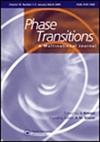Preparation of different crystal types TiO2 materials and its photodegradation performance in Congo Red wastewater
IF 1.4
4区 材料科学
Q3 CRYSTALLOGRAPHY
引用次数: 1
Abstract
ABSTRACT TiO2 gel was synthesized by the sol–gel method, and TiO2 photodegradation material (TiO2-PDM) was obtained after drying, grinding, and heat treatment, which was used for photodegradation of Congo Red wastewater. The Rietveld refinement method confirmed that the TiO2 material was anatase crystal when the calcination temperature was lower than 600°C. When the calcination temperature was between 600 and 750°C, the TiO2 material was anatase-rutile mixed crystal, and the proportion of rutile increased gradually. The content of the rutile crystal reached 98.3% at 800°C. Compared with TiO2-PDM at 800°C, TiO2-PDM at 500°C has a smaller crystal size and better dispersibility. The best photodegradation performance was identified as the 77.1% when the drying temperature was 80°C, the calcination temperature was 500°C, and the calcination time was 1.5 h. GRAPHICAL ABSTRACT The upper part is the preparation process of TiO2-PDM, and the lower part is the schematic diagram of the mechanism of TiO2-PDM degradation of Congo Red wastewater.不同晶型TiO2材料的制备及其在刚果红废水中的光降解性能
摘要采用溶胶-凝胶法合成了TiO2凝胶,并经干燥、研磨和热处理获得了TiO2光降解材料(TiO2-PDM),用于刚果红废水的光降解。Rietveld精炼方法证实,当煅烧温度低于600°C时,TiO2材料为锐钛矿晶体。当煅烧温度在600至750°C之间时,TiO2材料为锐钛矿-金红石混合晶体,金红石的比例逐渐增加。金红石晶体的含量在800°C时达到98.3%。与800°C的TiO2-PDM相比,500°C的TiO2-PDM具有更小的晶体尺寸和更好的分散性。当干燥温度为80℃,煅烧温度为500℃,煅烧时间为1.5时,光降解性能最佳,为77.1% h.图形摘要上半部分是TiO2 PDM的制备过程,下半部分是TiO2-PDM降解刚果红废水的机理示意图。
本文章由计算机程序翻译,如有差异,请以英文原文为准。
求助全文
约1分钟内获得全文
求助全文
来源期刊

Phase Transitions
物理-晶体学
CiteScore
3.00
自引率
6.20%
发文量
61
审稿时长
1.4 months
期刊介绍:
Phase Transitions is the only journal devoted exclusively to this important subject. It provides a focus for papers on most aspects of phase transitions in condensed matter. Although emphasis is placed primarily on experimental work, theoretical papers are welcome if they have some bearing on experimental results. The areas of interest include:
-structural phase transitions (ferroelectric, ferroelastic, multiferroic, order-disorder, Jahn-Teller, etc.) under a range of external parameters (temperature, pressure, strain, electric/magnetic fields, etc.)
-geophysical phase transitions
-metal-insulator phase transitions
-superconducting and superfluid transitions
-magnetic phase transitions
-critical phenomena and physical properties at phase transitions
-liquid crystals
-technological applications of phase transitions
-quantum phase transitions
Phase Transitions publishes both research papers and invited articles devoted to special topics. Major review papers are particularly welcome. A further emphasis of the journal is the publication of a selected number of small workshops, which are at the forefront of their field.
 求助内容:
求助内容: 应助结果提醒方式:
应助结果提醒方式:


